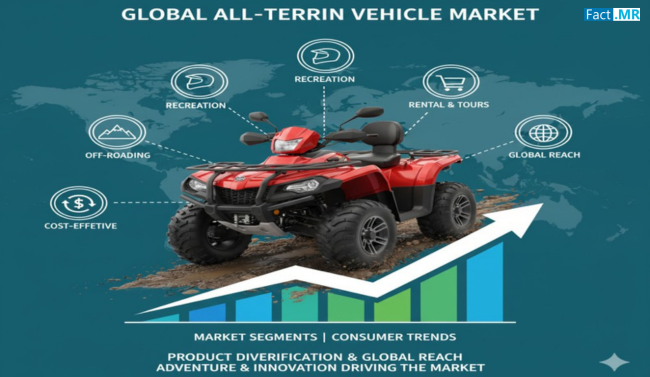The all-terrain vehicle (ATV) market is undergoing a remarkable transformation as off-road mobility becomes an essential part of outdoor recreation, agriculture, military operations, and industrial logistics. Advancements in vehicle design, powertrain technology, and safety systems have significantly enhanced the performance, reliability, and usability of ATVs across various terrains. This market’s growth reflects the expanding consumer interest in outdoor adventure sports and the increasing adoption of ATVs as versatile utility vehicles in commercial and defense sectors.
Market Overview:
All-terrain vehicles are designed to handle rugged landscapes, offering enhanced traction, stability, and maneuverability over uneven surfaces. These vehicles typically feature powerful engines, robust suspension systems, and adaptive transmission mechanisms that enable them to perform in diverse environments—from muddy trails and rocky hills to snow-covered paths and desert sands.
The modern ATV market encompasses a wide range of models, including utility ATVs for heavy-duty applications, sports ATVs for racing and recreation, and youth models designed for beginners. Manufacturers are focusing on combining durability with comfort, integrating ergonomic seating, lightweight frames, and smart connectivity features to deliver a better riding experience.
Sustainability is also shaping the industry’s direction, with electric ATVs emerging as a viable alternative to traditional combustion-engine models. These battery-powered variants promise quieter operation, lower emissions, and reduced maintenance requirements, aligning with global clean mobility goals.
Regional Insights:
North America remains the leading hub for ATV adoption, driven by a strong culture of recreational riding, established trail networks, and rising agricultural applications. The United States and Canada host numerous off-road sporting events, which continue to fuel vehicle sales and aftermarket services.
Europe follows closely, supported by growing interest in adventure tourism and eco-friendly vehicle innovation. Countries across Western and Northern Europe are increasingly using ATVs for forestry, defense, and mountain patrol operations.
Asia-Pacific is emerging as a dynamic growth region, where expanding disposable income, tourism development, and rural modernization are spurring demand for ATVs. Countries such as China, India, and Japan are also investing in electric mobility solutions, creating opportunities for domestic production and export.
Latin America and the Middle East & Africa are gradually gaining traction in the ATV market, largely due to increased adoption for agriculture, military logistics, and desert exploration. Infrastructure development and expanding recreational opportunities in these regions are expected to drive future growth.
Key Trends & Forecast:
- Electrification of Off-Road Mobility:
The introduction of electric ATVs marks a significant milestone in sustainable vehicle engineering. These models offer improved torque, quiet operation, and reduced carbon emissions—appealing to environmentally conscious consumers and organizations. - Integration of Smart Technologies:
ATVs are increasingly equipped with GPS navigation, smart diagnostics, ride control systems, and real-time performance tracking. Digital interfaces enhance user safety and allow riders to customize performance settings based on terrain and preference. - Rising Popularity of Recreational Sports:
Off-road racing, trail riding, and adventure tourism have become mainstream recreational activities. This trend continues to boost demand for high-performance ATVs with superior handling and enhanced safety features. - Commercial and Agricultural Utilization:
Beyond recreation, ATVs are becoming essential tools for agricultural and industrial applications. They are widely used for transportation, spraying, fencing, and hauling in rural and remote areas, owing to their compact size and ability to traverse uneven ground. - Safety and Regulatory Compliance:
Governments are introducing stringent safety standards for ATV design and usage. Manufacturers are responding by adding automatic braking systems, rollover protection, stability control, and improved lighting systems to ensure rider safety. - Customization and Aftermarket Growth:
The demand for customized ATVs and performance upgrades—such as suspension kits, tires, and engine enhancements—continues to rise, creating opportunities in the aftermarket ecosystem.
Applications & End-Use Outlook:
The all-terrain vehicle market serves a broad range of industries and user groups:
- Recreational Users: Enthusiasts seeking adventure sports, camping, and off-road exploration represent the largest segment of ATV users. The rise of outdoor tourism and social media influence continues to attract new participants.
- Agriculture and Forestry: Farmers and forestry operators rely on ATVs for land maintenance, crop inspection, transportation, and equipment towing. Their small footprint and versatility make them ideal for remote, off-road operations.
- Military and Defense: Defense organizations use ATVs for reconnaissance, cargo transport, and troop movement in rugged terrains where conventional vehicles cannot operate efficiently.
- Industrial and Utility Operations: Industries such as oil & gas, construction, and mining deploy ATVs for equipment transport, site inspection, and maintenance tasks across challenging terrains.
- Search and Rescue Operations: ATVs play a critical role in emergency response scenarios, enabling rapid mobility across difficult landscapes during natural disasters or medical emergencies.
Competitive Landscape:
The ATV market features a mix of global brands and regional manufacturers competing through innovation, product differentiation, and service excellence. Companies are investing heavily in research and development to create next-generation models with enhanced performance, comfort, and sustainability features.
Collaborations between automotive and technology firms are becoming increasingly common, leading to the development of connected ATVs equipped with data analytics, remote diagnostics, and safety monitoring systems. Manufacturers are also expanding their global footprints through partnerships, distribution networks, and localized production facilities to meet rising demand in emerging markets.
Brand loyalty and customer engagement play crucial roles in this industry. Many manufacturers focus on organizing off-road events, rider clubs, and community programs to strengthen brand identity and foster long-term relationships with consumers.
Conclusion:
The all-terrain vehicle market stands at an exciting crossroads where technology, adventure, and sustainability converge. With advancements in electrification, digital connectivity, and ergonomic design, ATVs are no longer confined to recreational use—they are evolving into intelligent, multi-purpose machines suited for a variety of industries.
As manufacturers continue to innovate, and consumers embrace outdoor mobility, the future of the ATV market looks both dynamic and promising. Businesses operating in this sector can benefit from aligning with eco-friendly production, investing in electric vehicle technologies, and expanding into untapped regional markets.
Ultimately, all-terrain vehicles symbolize freedom, versatility, and endurance—qualities that will continue to drive their relevance in a rapidly changing global mobility landscape.



